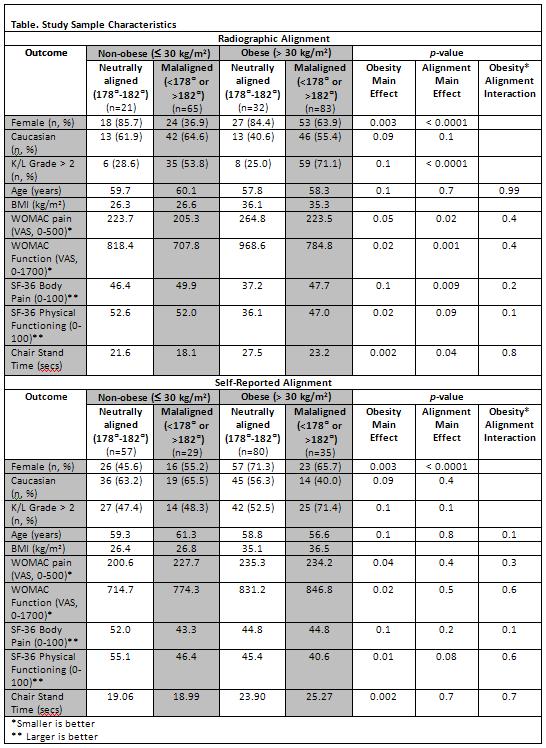Session Information
Session Type: Abstract Submissions (ACR)
Background/Purpose: Malalignment is a potential risk factor for structural progression of knee osteoarthritis (OA), but data conflict as to its association with knee pain. We hypothesize that subjective alignment measures are less burdensome and yield results similar to radiographic measures. As obesity is also associated with pain in knee OA, there could be interactions between obesity and alignment when assessing pain and function. Thus, we investigated if pain and function differ between obese and non-obese individuals with and without knee malalignment using both radiographic and self-reported classification of alignment.
Methods: We used baseline data derived from two clinical trials for symptomatic knee OA. Both trials used similar definitions of knee OA (ACR radiographic criteria). We assessed pain and function at baseline with the WOMAC and Short Form 36 Health Survey (SF-36) subscales and chair stand time. Participants were asked if they perceived themselves as bow-legged, straight-legged, or knock-kneed. One reader measured anatomic axis from posteroanterior fixed-flexion weight-bearing knee radiographs using a validated standard method [ICC (3, 1) = .94]. We adjusted anatomic axis measures (female, -3.5°; male, -6.4°) to better reflect mechanical axis and categorized them using typical definitions (see table). To analyze the influence of malalignment, obesity, and their interaction, we performed a 2 (obesity) x 2 (alignment) analysis of variance for each outcome. We conducted analyses using the self-report and radiographic classifications with varus (< 178°) and valgus (> 182°) groups collapsed.
Results: Characteristics of our 201 participants, stratified by obesity and radiographic alignment, are shown in the table. Using radiographic classification, malaligned groups had better WOMAC pain and function, SF-36 body pain, and chair stand time, independent of obesity. Using self-report classification, malaligned groups had worse WOMAC pain and function, SF-36 body pain and physical function, and chair stand time, again independent of obesity, but no outcome reached statistical significance. We found no significant interactions between obesity and either alignment method. Multiple sensitivity analyses using 3 categories of alignment, restricting analyses to women, and examining the trials separately, did not change the results.
Conclusion: Conventional wisdom suggests that both obesity and malalignment should cause more pain in people with knee OA. However, our results suggest that assessing the exposure of malalignment using radiographs vs. self-report may yield different, counterintuitive, results. Because more people classified themselves as neutrally aligned, the discrepancy could not have been due to a perceived connection between malalignment and pain. Studying these classifications of exposure with longitudinal outcomes will provide further insights into their relative utilities.
Disclosure:
E. M. Erickson,
None;
J. B. Driban,
None;
L. L. Price,
None;
C. Wang,
NIH,
2;
T. E. McAlindon,
NIH,
2;
W. F. Harvey,
Vindico Medical Education,
5.
« Back to 2013 ACR/ARHP Annual Meeting
ACR Meeting Abstracts - https://acrabstracts.org/abstract/classification-of-alignment-by-self-report-versus-radiograph-results-in-unexpected-and-discrepant-pain-and-functional-outcomes/

